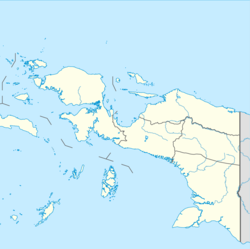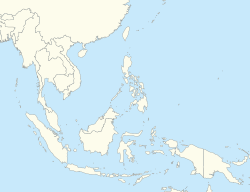This article needs additional citations for verification. (July 2024) |
Meyah (Meyakh) is a West Papuan language spoken in North Manokwari District, Manokwari Regency, West Papua, Indonesia. The Meyah language is agglutinative and head-marking and has no grammatical cases. It has subject-verb-object word order, which comes from nearby Austronesian languages.[2][3]
| Meyah | |
|---|---|
| Meyakh | |
| Native to | Indonesia |
| Region | North Manokwari District, Manokwari Regency, West Papua |
Native speakers | 15,000 (2000)[1] |
West Papuan
| |
| Language codes | |
| ISO 639-3 | mej |
| Glottolog | meya1236 |
| Coordinates: 0°46′01″S 133°52′52″E / 0.767°S 133.881°E | |
Phonology
editMeax has 5 vowels and 13 consonants.
| Front | Central | Back | |
|---|---|---|---|
| Close | i | u | |
| Mid | ɛ ⟨e⟩ | o | |
| Open | a |
| Bilabial | Alveolar | Palatal | Velar | Glottal | ||
|---|---|---|---|---|---|---|
| Nasal | m | n | ||||
| Plosive | voiceless | t | tʃ ⟨c⟩ | k | ||
| voiced | b | d | dʒ ⟨j⟩ | g | ||
| Fricative | ɸ ⟨f⟩ | s | h | |||
| Trill | ɾ ⟨r⟩ | |||||
| Glide | (w) | (j) | ||||
Pitch-accent
editLike many other Papuan languages of the Bird's Head Peninsula,[which?] Meyah is a pitch-accent language with two phonemic pitch levels: rising high and falling high, which contrast.
| Rising | Falling |
|---|---|
| éj 'drink' | èj 'peel' |
| mós 'fish' | mòs 'toad' |
Some two- and three-syllable words also have pitch accent. For example, éfes 'young' contrasts with efés 'fat', and óboha 'skull' contrasts with obóha 'tools' and obohá 'spoiled'.[7]
Grammar
editPronouns
editPronouns demonstrate three numbers: singular, dual, and plural. The first person dual and plural pronouns also demonstrate clusivity.
| Singular | Dual | Plural | ||
|---|---|---|---|---|
| 1st | exc. | didif | magif | memef |
| inc. | nagif | mimif | ||
| 2nd | bua | goga | iwa | |
| 3rd | ofa | rua | ||
| Singular | Dual | Plural | ||
|---|---|---|---|---|
| 1st | exc. | di- | ma- | me- |
| inc. | na- | mi- | ||
| 2nd | bi- | ge- | i- | |
| 3rd | ø- | ri- | ||
These prefixes are used for verbs, body parts and kinship terms.
Nouns
editNouns in Meyah are divided into two types: alienable and inalienable, the latter of which includes terms for body parts and kinship relations, and are obligatorily marked for possessor. With alienable nouns, there is morphological complexity. The plural marker -ir can only be used with humans, pigs, and dogs. There is no other method of indicating plurality for other alienable nouns. For inanimate nouns, a plurality may be indicated by certain modifiers such as:
mod
house
ofokou
many
mod
house
efaga
CLF
orgomu
three
Kinship
editKinship terms, as inalienable nouns, share the same possessor prefixes as body parts and verb stems, however, they differ in the singular possessive prefixes. Instead of the '(C)i-' prefix found on first and second singular prefixes, kinship terms have 'ed-.' (1st singular) and eb- (2nd singular). On verbs and other inalienable nouns, the third person singular possessive prefix is normally unmarked, but kinship terms use the same prefix as the first person plural exclusive, me-. Terms for important kinship relations have divergent morphology, like the lack of a first-person singular possessive prefix for father akeina and mother ameina, which are also used to refer to father and mothers' brothers respectively.
Classes
editThere are six classes of nouns, which are differentiated on the basis of their classifier when they are modified by a numeral. The first class is a class used exclusively for humans. Classes two and three relate to food, with the former being for food growing underground and the latter being for food growing on trees and vines. When this food is removed from trees or vines, it is classified according to whether it is 'round,' placed in the fourth class, and 'flat,' found in the fifth class. Class six consists of terms for animals and 'house.'[2]
Notes
edit- ^ Meyah at Ethnologue (18th ed., 2015) (subscription required)
- ^ a b "Odé 2002". wals.info. Retrieved 18 August 2018.[failed verification]
- ^ Gravelle, Gilles (1998). "Perspectives on the Bird's Head of Irian Jaya, Indonesia". In Miedema, Jelle; Odé, Cecilia; Dam, Rien A.C. (eds.). Proceedings of the Conference, Leiden, 13–17 October 1997. Rodopi. pp. 555–573. ISBN 978-90-420-0644-7.
- ^ Gravelle 2011, p. 30.
- ^ Gravelle 2011, p. 23.
- ^ Gravelle 2011, p. 39.
- ^ Gravelle 2011, pp. 39–40.
References
edit- Gravelle, Gilles (2011). Meyah: a language of West Papua, Indonesia. Pacific Linguistics. Vol. 619. Canberra: Research School of Pacific and Asian Studies, Australian National University. ISBN 978-0-85883-625-9.
Further reading
edit- Gravelle, Gilles (2002). "Morposyntactic Properties of Meyah Word Classes". In Reesink, Ger P. (ed.). Languages of the Eastern Bird's Head. Pacific Linguistics. Vol. 524. Canberra: Research School of Pacific and Asian Studies, Australian National University. pp. 109–180. doi:10.15144/PL-524.109. hdl:1885/146144. ISBN 978-0-85883-494-1.
- —— (2004). The Meyah Language of Papua (PhD thesis). Vrije Universiteit Amsterdam.

